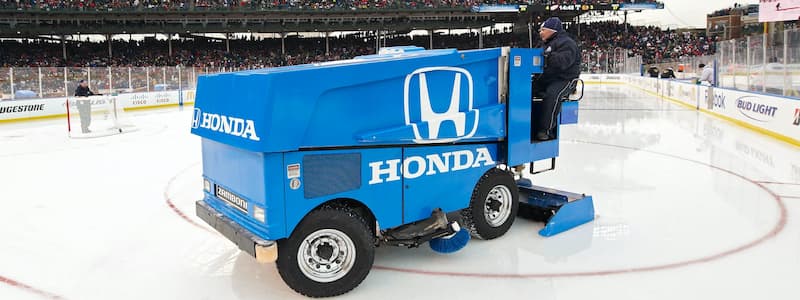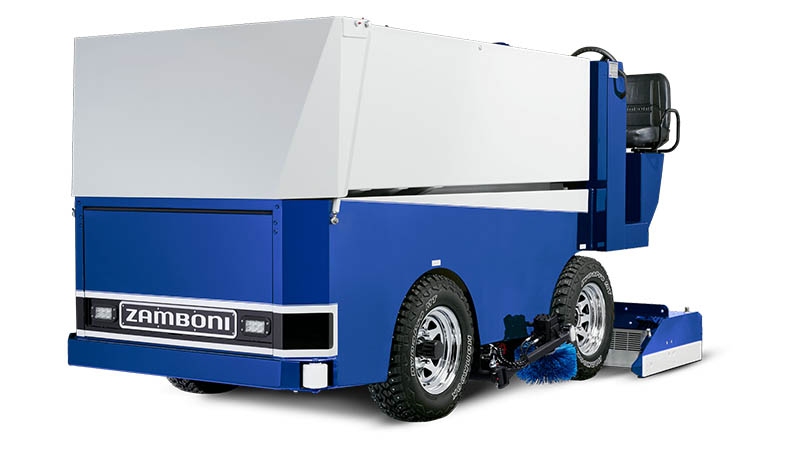An ice resurfacing machine—or ‘zamboni‘—operates by shaving the top layer of ice off of a hockey rink, washing the remaining ice, and then spreading out an even layer of water that freezes in between periods/skate times; resurfacing the ice with a zamboni helps maintain a pristine skating surface for the players. Everybody has experienced a day when the ice could have used some TLC; ice resurfacers temporarily reduce chattering, skipping, and a “gritty” feeling on the ice.
In this article, the definition of a Zamboni, its origin story, and how it treats ice will all be covered.
Table of Contents
What is a Zamboni
A Zamboni is a sizable vehicle that is furnished with a long blade, an ice reservoir, a hose, a squeegee, a cloth applicator, a water heater, and numerous other devices to carry out its duties. Despite the fact that most drivers do not even travel at half that speed, zambonis can only travel at speeds of 9 miles per hour. A single Zamboni can clean an entire ice rink in under 8 minutes, despite being rather challenging to drive.
How Does a Zamboni Work?
It begs the questions, “How do Zambonis work and are they difficult to operate?” given the significance of the job of Zamboni drivers and the fascinating nature of the profession.
A Zamboni is a sizable mechanical machine used for resurfacing ice. It functions by using a big blade to shave the ice, then pouring water into the ice’s grooves. Excess water and snow are collected on the Zamboni tank during the procedure so it can be reused later to complete the task again.
Remaining snow from the shavings will be emptied from the Zamboni’s tank after the operator has resurfaced the ice. If you have ever been to a hockey arena, you will notice that there is still some snow outside the building during the summer. The Zamboni created that snow pile.
However, a Zamboni’s mechanics are actually quite straightforward, despite the fact that the equipment frequently has an outdated, complicated appearance. If you want to get a better idea of how to operate a Zamboni, watch the video below.
History of the Zamboni
In 1949, Frank Zamboni created the Zamboni. Before the Zamboni, workers had to manually scrape and clean the entire ice rink with squeegees, sponges, and buckets of water. The ice rink needed to be cleaned several times throughout the day, which was a very labor-intensive and back-breaking task. Today’s zambonis can clean an ice rink quickly and thoroughly in a matter of minutes, and they are now regarded as mascots in any given ice rink.

What a Zamboni Actually Does?
Shaving
A Zamboni first shaves the ice. In order to prevent hockey players and figure skaters from injuring themselves, this is done. Due to the sharpness of hockey skate blades, they frequently rip up the ice, leaving behind uneven scars and sharp edges. With a blade that weighs 57 pounds, measures 70 inches long, and is ½ inch thick, a Zamboni can quickly shave the ice.
Collecting
The Zamboni uses a lengthy, horizontal screw-like mechanism to shave the ice and collect the shavings as it does so. The horizontal screw then pushes the ice shavings into a vertical screw that carries the ice shavings to a device known as a “slinger”. The slinger is a paddle that rotates and throws the ice shavings into a large reservoir called a “snow tank” that sits at the front of the Zamboni.
Washing
The ice rink needs to be washed after the Zamboni has finished collecting the ice shavings. The Zamboni has a hose that, when used for this task, sprays lukewarm water onto the ice in front of a squeegee. Simply to remove any residue that may be on the ice, water is used in this process. Coins, teeth, and other debris are scraped up by the squeegee and collected in a sizable tray that is positioned behind the squeegee in front of the Zamboni.
Resurfacing
It’s time to resurface the ice to give hockey players and skaters a smooth, clean surface to skate over after the ice rink has been cleaned and groomed. The Zamboni sprays the ice with water that is 140 degrees Fahrenheit hot for this task. Coils on the bottom of the Zamboni freeze the fresh water as it passes over it in a matter of seconds. Hockey games and other events can go on as scheduled since the entire process only takes a few minutes.
How Much Does a Zamboni Cost?
Zambonis are large, bulky vehicles that can be driven on ice. They have many features. It goes without saying that these things are expensive, but how expensive?
Depending on the model, accessories, equipment, and other details, a Zamboni can cost anywhere from $10,000 to $250,000.
What kind of Zamboni hockey halls will choose to invest in depends on factors such as how frequently one would use one, ice resurfacing requirements, power requirements, and speed requirements. Naturally, NHL teams have the most technologically advanced Zambonis with all the bells and whistles, whereas neighborhood ice rinks don’t need sophisticated features to do the job.
Now let’s quickly review some of the most well-known Zamboni models, their costs, and their features.
Model 100
The model 100 Zamboni is a fuel-powered, small tractor-pulled device. They work well for smaller ice areas in neighborhood rinks where style or timing aren’t as crucial as they are in professional competitions. They are quite rarely seen and cost the least, approximately $10,000.
However, full-sized, tractor-less Model 100 Zambonis are also available. Depending on the specific Zamboni, these machines can cost close to $100,000.
Model 700
Model 700 Zambonis are superior to Model 100, costing anywhere between $100,000 to $200,000.
They have wider blades and more advanced ice-making systems that are better suited to larger ice surfaces and workloads.
Zamboni 552
The Zamboni 552 is distinct from the models 100 and 700 because it has a lead acid battery. This is seen in the price, from $160,000 to $250,000 or more! They are designed for environments with even higher demands.
This model is also environmentally friendly because it doesn’t require fuel to operate and has enough power to complete tasks quickly even in professional leagues at a speed of 60 mph (96 kph).
Olympia Zamboni
The Olympia Zamboni is comparable to the model 552. They are bigger and wider, but at the expense of speed. However, compared to other models, this one allows you to resurface ice even more quickly. Of course, they are the most expensive model costing from $200,000 to $250,000.
How to Become a Zamboni Driver
Getting in touch with the manager of the nearby ice arena and asking if they need help is the best way to start working as a zamboni driver. Searching through regional arena websites and local classifieds may also reveal opportunities. The appeal of complimentary rinkside seats is one reason why the majority of drivers are hockey enthusiasts who work part-time at entry-level wages. The new driver is frequently mentored by an experienced one, and savvy arena managers will always have two ice machine operators on hand in case one of them becomes ill.
What Does It Take to Drive a Zamboni?
A Certified Ice Technician (CIT) professional designation is an option, but it is not necessary for drivers to have one in order to operate an ice resurfacing machine. People who hold the CIT designation have received training in all facets of arena ice maintenance, including ice installation, HVAC, and ice resurfacer maintenance and operation. Only those who want to drive or work full-time for larger arenas and/or professional teams typically need to become CITs. A CIT might move from one arena to another in order to further their own professional or personal objectives. CIT certifications are offered in the United States through the United States Ice Rink Association with the applicable courses being offered at regular intervals.
Is Driving a Zamboni Difficult?
Every hockey fan would adore to operate (or at the very least ride in!) a zamboni!) It’s not as easy to drive around in a circle while putting water down on an ice resurfacer. When taking the ice, a zamboni driver must take into account a variety of factors, including how deep the ice shaver is cutting, how much water to apply, how quickly you should apply it, where the refrigeration unit beneath the ice isn’t working well, how to remove ice that has built up along the boards, and even the type of skating that takes place at the rink. All skaters ought to owe the good ones gratitude because zamboni drivers have a significant impact on how the ice plays. Due to their expertise in all things relating to the nature of the ice, drivers designated as CITs are highly sought after by top tier organizations.



